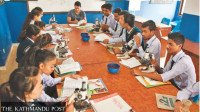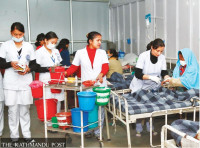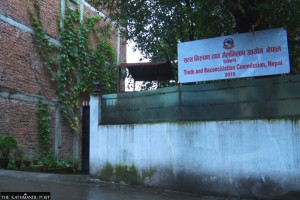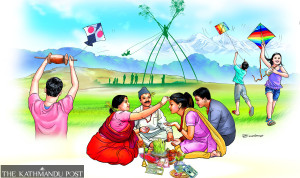Miscellaneous
Turkish Airlines jet crash-lands at TIA
A Turkish Airlines plane skidded off the runway and veered onto the grassy shoulder after losing balance during landing at the Tribhuvan International Airport
Sangam Prasain
Initial reports suggest that a loss of situation awareness of the flight captain during the final approach resulted in the Airbus A330 missing the runway’s centre line.
Flight TK726 from Istanbul was carrying 224 people when it ploughed into the grassland on the left side of the runway at Kathmandu’s fog-covered airport at 7:45am. No major injuries have been reported. All the passengers were evacuated through the emergency doors.
The TIA said the jet skidded and stuck in a grassland 1,000 metres from the southern tip of the Runway 02 approach point. The plane’s front landing gear has collapsed and its belly, wings and two engines have been damaged, Ratish Chandra Lal Suman, director general of the Civil Aviation Authority of Nepal (Caan), told a press conference 11 hours after the accident.
The aircraft came to rest with the left landing gear on the grassy shoulder and the right one on the runway, said an air traffic controller (ATC).
“The plane’s tyres may have deflated or burst from overheating due to the uneven surface,” said the on-duty ATC official on condition of anonymity. “As the pilots were unable to control the plane, it skidded and ploughed into the grassland.”
The official said the accident occurred during the jet’s second attempt to land.
It was operating under the Required Navigation Performance-Authorization Required (RNP-AR) approach procedure—a satellite-based navigation system—that allows aircraft to fly on its proper route automatically without relying on ground-based navigational aids.
During the first attempt to land, the pilot did not see the runway when the aircraft was a mile outside the approach gate.
“The crew was then forced to conduct a ‘missed approach’ and diverted 17 miles to the south for another approach,” the ATC official added.
During the first attempt, the airport had 1,000 metre visibility. Under the RNP-AR, aircraft are allowed to land at 900-metre visibility.
The ATC had cleared the aircraft to land a second time at 7:40am.
The pilots were then asked if they could see the runway when the aircraft was at the height of 5,600 feet. “But the pilot did not reply,” the official revealed.
“The airport was suddenly covered with a dense fog when the aircraft made the final approach.”
After 3-4 minutes, the pilots reported to the ATC that they had landed on the grassy shoulder, the official explained.
The airport was immediately closed, and rescue and fire fighting teams were dispatched to the site.
“It took 90 seconds to evacuate the passengers,” Caan chief Suman said.
Meanwhile, Turkish Airlines said that it would make public the cause of the incident involving its jet at the TIA after a technical investigation.
The carrier tweeted that it was taking the necessary measures following the mishap of its Airbus
A330. “Necessary precautions are taken; after the technical investigation, this unfortunate incident will be determined and announced to public,” the Turkish Airlines twitter handle read.
Crash timeline
- Flight TK726 from Istanbul was carrying 224 people
- The ATC had cleared the aircraft to land a second time at 7.40 am
- Landed at Kathmandu’s fog-covered airport at 7:45 am
- Jet skidded and stuck in a grassland 1,000 metres from the southern tip of the runway
- During the first attempt, the airport had 1,000 metre visibility
Indian Air Force plane to ferry removal kit today
An Indian Air Force C-130J transport aircraft, carrying the “removal kit” to tow the stranded Turkish Airlines jet, is scheduled to land at the TIA on Thursday morning. The C-130J is meant for an array of operations including difficult landings. The airforce plane, which is capable of landing on a shorter runway, will approach the airport from the northern point, Caan chief Ratish Chandra Lal Suman said. “The government on Wednesday requested the Indian government for help to transport the removal kit.” (I)
4-man panel to probe crash
The Ministry of Culture, Tourism and Civil Aviation on Wednesday formed a four-member investigation committee under the chairmanship of former tourism secreatry Nagendra Ghimire to look into the Turkish Airlines mishap.
Senior Captain Bishwambhar Man Amatya and Nepal Airlines engineer Chudamani Bashyal are the members.
Buddhi Sagar Lamichhane, joint secretary at the ministry, has been appointed the member-secretary of the committee. The panel has to submit its report in 90 days.




 24.67°C Kathmandu
24.67°C Kathmandu












